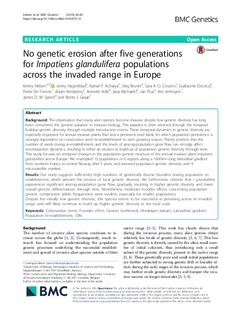| dc.contributor.author | Helsen, Kenny | |
| dc.contributor.author | Hagenblad, Jenny | |
| dc.contributor.author | Acharya, Kamal Prasad | |
| dc.contributor.author | Brunet, Jörg | |
| dc.contributor.author | Cousins, Sara A. O. | |
| dc.contributor.author | Decocq, Guillaume | |
| dc.contributor.author | De Frenne, Pieter | |
| dc.contributor.author | Kimberley, Adam | |
| dc.contributor.author | Kolb, Anette | |
| dc.contributor.author | Michaelis, Jana | |
| dc.contributor.author | Plue, Jan | |
| dc.contributor.author | Verheyen, Kris | |
| dc.contributor.author | Speed, James D M | |
| dc.contributor.author | Graae, Bente Jessen | |
| dc.date.accessioned | 2019-03-18T09:27:17Z | |
| dc.date.available | 2019-03-18T09:27:17Z | |
| dc.date.created | 2019-02-21T17:06:44Z | |
| dc.date.issued | 2019 | |
| dc.identifier.citation | BMC Genetics. 2019, . | nb_NO |
| dc.identifier.issn | 1471-2156 | |
| dc.identifier.uri | http://hdl.handle.net/11250/2590415 | |
| dc.description.abstract | Background
The observation that many alien species become invasive despite low genetic diversity has long been considered the ‘genetic paradox’ in invasion biology. This paradox is often resolved through the temporal buildup genetic diversity through multiple introduction events. These temporal dynamics in genetic diversity are especially important for annual invasive plants that lack a persistent seed bank, for which population persistence is strongly dependent on consecutive seed ‘re-establishment’ in each growing season. Theory predicts that the number of seeds during re-establishment, and the levels of among-population gene flow can strongly affect recolonization dynamics, resulting in either an erosion or build-up of population genetic diversity through time. This study focuses on temporal changes in the population genetic structure of the annual invasive plant Impatiens glandulifera across Europe. We resampled 13 populations in 6 regions along a 1600 km long latitudinal gradient from northern France to central Norway after 5 years, and assessed population genetic diversity with 9 microsatellite markers.
Results
Our study suggests sufficiently high numbers of genetically diverse founders during population re-establishment, which prevent the erosion of local genetic diversity. We furthermore observe that I. glandulifera experiences significant among-population gene flow, gradually resulting in higher genetic diversity and lower overall genetic differentiation through time. Nonetheless, moderate founder effects concerning population genetic composition (allele frequencies) were evident, especially for smaller populations.
Despite the initially low genetic diversity, this species seems to be successful at persisting across its invaded range, and will likely continue to build up higher genetic diversity at the local scale. | nb_NO |
| dc.language.iso | eng | nb_NO |
| dc.publisher | BioMed Central | nb_NO |
| dc.rights | Navngivelse 4.0 Internasjonal | * |
| dc.rights.uri | http://creativecommons.org/licenses/by/4.0/deed.no | * |
| dc.title | No genetic erosion after five generations for Impatiens glandulifera populations across the invaded range in Europe | nb_NO |
| dc.type | Journal article | nb_NO |
| dc.type | Peer reviewed | nb_NO |
| dc.description.version | publishedVersion | nb_NO |
| dc.source.pagenumber | 11 | nb_NO |
| dc.source.journal | BMC Genetics | nb_NO |
| dc.identifier.doi | https://doi.org/10.1186/s12863-019-0721-4 | |
| dc.identifier.cristin | 1679712 | |
| dc.description.localcode | © The Author(s). 2019. This article is distributed under the terms of the Creative Commons Attribution 4.0 International License (http://creativecommons.org/licenses/by/4.0/), which permits unrestricted use, distribution, and reproduction in any medium, provided you give appropriate credit to the original author(s) and the source, provide a link to the Creative Commons license, and indicate if changes were made. | nb_NO |
| cristin.unitcode | 194,66,10,0 | |
| cristin.unitname | Institutt for biologi | |
| cristin.ispublished | true | |
| cristin.fulltext | original | |
| cristin.qualitycode | 1 | |

